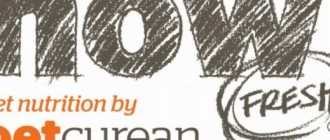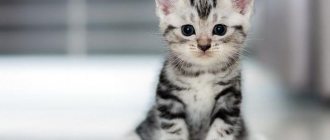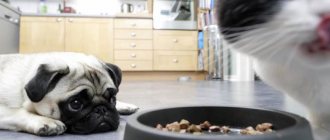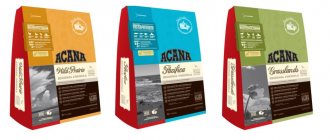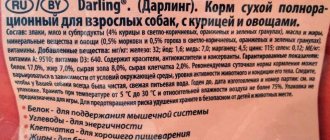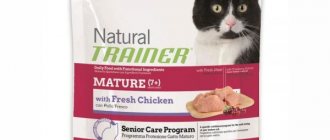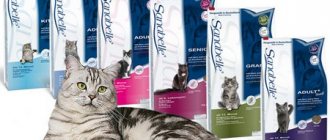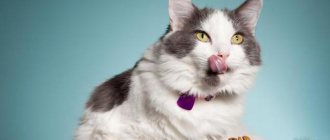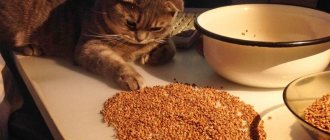Reasons why a cat may refuse dry food
There are many reasons that can cause a cat to refuse pelleted food. Some of them are associated with natural physiological factors, others are not normal and can threaten the cat’s life.
Diseases
Many diseases can provoke a refusal of dry food. The owner needs to pay attention to the general condition and behavior of the animal. If the cat is interested in the food, sniffs it and tries to eat, but at the last moment turns away or spits out the pellets, this may indicate damage to the gastrointestinal tract or the presence of a foreign body or neoplasm in it.
With dermatological diseases affecting the area around the mouth, the cat retains its appetite, but cannot eat due to pain
Pathology can affect not only the intestines or mucous membranes of the esophagus and stomach, but also the oral cavity. Animals often refuse dry food due to toothache. At first it causes discomfort, but the cat continues to eat. Later, as the pain intensifies, a kind of reflex arises, and the pet turns away from food. Interest in wet food and natural products can be maintained: softened food causes less discomfort. With dental diseases, a pet may chew on hard objects in order to independently get rid of the source of pain. Most often, an injury or signs of pathology can be detected by visual examination, but in some cases an x-ray is required.
Tartar can lead to the loss of fangs, so regular brushing with a special brush is recommended.
New growths in the oral cavity can cause no less discomfort. During eating, they can be injured by teeth or hard granules. In some cases, this can cause bleeding. Most often, tumors can be detected independently. They can be soft, hard, movable, fixed, white, black, etc.
Depending on the location of the tumor, the animal may experience increased salivation and difficulty swallowing
With diseases and damage to the musculoskeletal system, a cat may refuse dry food and other food while maintaining appetite due to limited mobility and pain. In such cases, the animal experiences severe discomfort, meows, limps, drags its paws or cannot rise at all, defecates under itself, etc. The condition is one of the most dangerous, so it is important to carefully deliver the cat to the veterinarian without causing it additional pain.
In some cases, the animal completely refuses dry food. It has no interest in it or other food. The pet is hungry, but at the sight of food it immediately turns away or leaves. This symptom may accompany the following diseases and conditions:
- Intoxication. Poisoning is accompanied by rapid heartbeat, nausea, vomiting, digestive disorders, fever, etc. In severe cases, loss of orientation in space occurs. In a critical condition, the cat stops reacting to what is happening, and the body temperature drops. Possible failure of internal organs. In case of mild intoxication, after the poisoning is removed, the condition returns to normal without additional intervention. If the cat’s health deteriorates significantly, the cat is fed through a tube and given intravenous infusions to prevent dehydration.
- Lipidosis. The disease is characterized by excessive accumulation of fat in the liver. The animal may eat poorly or completely refuse food for a long period of time (2-4 weeks or more). The cat quickly loses weight, and the ribs, breastbone and hips become visible. The animal is worried about digestive disorders and jaundice. In case of lipidosis, appetite must be corrected as part of general therapy, since irreversible processes often begin to occur in the body.
- Internal injuries. The main signs of illness are hidden bleeding, swelling and severe pain. If the cat's gastrointestinal tract is damaged, blood may be detected in the stool. In the absence of severe exhaustion, the animal’s condition returns to normal on its own after treatment.
If the tissues of the urinary system have been injured, blood impurities or solid clots will be present in the urine; indirectly, color allows you to determine the location of damage
- Infections. The reason for refusing dry food can be both gastrointestinal lesions and, for example, cystitis. In this case, poor appetite is associated with intoxication of the body by bacteria and their decay products. The animal definitely needs treatment, even if the symptoms have weakened or disappeared without treatment. Improvement in condition may indicate that the disease has become chronic.
- Gastrointestinal pathologies. The pet does not eat well or refuses dry food due to inflammation and pain in the abdomen, as well as nausea. If an animal eats both pellets and natural products, it may choose the latter. Foods that are high in liquid cause less pain due to their softer texture.
When feeling nauseous, your cat will often lick its nose.
- Disorders of the central nervous system and brain. Most often this is observed with injuries. Appetite problems are associated with impaired transmission and recognition of nerve signals. As a result, the cat does not feel hungry while the body needs energy and nutrients. Treatment is mandatory; if necessary, the pet is fed through a tube.
- Helminthiasis. Infection with worms can occur through eating raw meat, contact with other animals, or accidentally ingesting parasite larvae along with insects, soil or water. With mild helminthiasis, weight loss, deterioration in general health, and mucus and blood in the stool are observed. Larvae or whole worms may be found in natural secretions and vomit. In severe cases, worms cause intestinal obstruction. After taking anthelmintics twice, the symptoms disappear; only animals in critical condition need additional correction.
- Inflammatory processes that accompany acute and chronic diseases. Deterioration of appetite can occur with any pathology due to the active functioning of the immune system. Most of the energy is spent by the body on eliminating inflammation, so the pet feels weak and loses its appetite.
- Intestinal obstruction. Refusal of dry food is associated with blockage of the gastrointestinal tract and the impossibility of normal movement of food and feces. In such cases, the cat experiences pain. With partial obstruction, the animal is bothered by bloating and diarrhea, with complete obstruction - constipation. Nausea appears. Without help, the pet may die. After normalization of the condition, the cat gradually returns to a normal diet.
Partial refusal of dry food and selectivity may be caused by visual or olfactory impairments. In this case, this is due to the unattractiveness of the food. Cats navigate by sight and smell, so if they lose their senses, they may suffer from poor appetite. If the situation does not improve after normalization of the pet’s condition and a course of therapy, owners are advised to use additional tricks to increase the attractiveness of the food.
One day my cat started refusing dry food. At first I didn’t suspect anything, because approximately every 2 months she arranges several fasting days for herself: she eats less or goes hungry altogether. When problems with appetite began to become permanent, I became wary and decided to examine the cat: I carefully felt her stomach, looked into her ears and eyes, and checked her skin. The reason became clear when it came to the mouth. There were tartar on the chewing fangs, the gums around were red, and one of the teeth was loose. When I began to analyze, I remembered that recently the cat was often mischievous: she chewed wires, headphones, and even ruined several pairs of shoes, which was unusual for her. After removing the problematic fang, ultrasonic cleaning and treatment with dental gels, the appetite gradually returned to normal.
Lack of experience
Refusing food if the cat has not tried pellets before is a normal reaction. The animal understands that it is edible, but the unusual smell and consistency repels it. The cat will not die of starvation and sooner or later will begin to eat dry food, but a gradual transition is preferable. Otherwise, due to a sudden change in the menu, the animal may suffer from digestive disorders, exacerbation of chronic pathologies and the development of new diseases.
Spoiled food
Dry food remains conditionally suitable for consumption for 2–3 years, however, after opening the package, the shelf life is greatly reduced. This is due to the fact that the granules contain oils. When exposed to air, they quickly oxidize and go rancid. Depending on the storage method, the food will spoil after 3–8 weeks. Once rancid, it should not be given to cats as it may cause poisoning.
It is strongly recommended to refuse to buy food in bulk, especially if we are talking about super-premium class or higher: it is not known how long ago the package was opened
When I got my second cat, my dry food consumption increased. I decided to save money: buy large packages. This made it possible to reduce the cost of 1 kg of feed by an average of 20%. However, within a month the cats did not have time to eat all the contents. About a third of the volume remained in the bag when they both refused food. At first I thought they just didn't want to eat, but after a day it became obvious that something was wrong. When I gave the cats wet food, they readily ate it, as well as kibble from another package. We had to get rid of spoiled food. Now I buy small packages and make sure they have a zip closure. It partially prevents contact with air, so it does not allow the feed to spoil prematurely.
Pickiness
Cats are somewhat like children: if they understand that they can get something tasty, they will strive to achieve this by any means necessary. Whims are also on the list. If a cat once refused dry food, and the owner began to offer her delicacies or spoon-feed her, she will remember this. In the future, the pet will copy the previous behavior in order to get attention and extra treats.
Feeding "from the table" is fraught with begging and even theft
Animals can be very stubborn in their whims. Once upon a time one of my cats was sick. To make sure she got something to eat, I gave her her favorite wet food and dried chicken pieces. The cat recovered, but a month later she went on a hunger strike. I was afraid that she might start to lose weight, so I started giving her treats again and took her to the vet. The specialist said that everything was fine with the animal and advised him to ignore pickiness and just leave the food freely available. For about 2 days the cat became stubborn. I felt sorry for her, I constantly wanted to feed her, but I listened to the veterinarian. After this, the cat began to eat the pellets with the same appetite.
Getting used to flavor enhancers
Getting used to flavor enhancers can be a problem when switching from one food to another. Most often, this is encountered by those owners whose cats previously ate economy-class products.
Economy-class food for cats can be compared to fast food for people: there is little useful in them, but after such nutrition it is difficult to switch the animal to a healthy diet
Animals completely ignore the bowl of new food until hunger becomes unbearable. The owner's behavior should be the same as in the previous case: it is recommended not to pay attention to pickiness and observe so as not to miss uncharacteristic symptoms that may indicate illness. It is advisable to gradually switch your pet from one food to another.
Stress
Cats, like people, can experience problems with their appetite when they are mildly ill, in a bad mood or under stress. Since animals are conservative, even insignificant events for us can cause a behavioral disorder. For example, the arrival of a child or a new pet for neighbors, the relocation of some family members, or the rearrangement of furniture.
On the upper floors of the play complex the cat will feel as comfortable as possible, because from there she can watch what is happening from above
To normalize the condition, it is recommended to give the cat its own territory, where no one will disturb it. This will protect your pet from unwanted attention and help improve sleep. This is especially important if the family has small children, dogs or other cats. It is advisable to purchase a play complex or house. This is more aesthetically pleasing, although for cats even a cardboard box is a shelter. It is recommended that restless animals be crate trained from childhood to protect them from accidents. While the owner is not at home, the cat may chew through the wires or fall out of the window. The cage prevents this and serves as a kind of personal room for the pet.
When animals are stressed, they have problems sleeping: it becomes superficial, so the pet doesn’t get enough rest, which further aggravates the situation.
To combat stress, it is recommended to pay more attention to the cat, talk to it, play and pet it more often. This will allow the pet to feel like part of the family and strengthen its position in the “pack”. These measures cannot be ignored if stress is associated with the appearance of a new animal. Otherwise, the pets will begin to sort things out among themselves and become aggressive.
Malaise and poor appetite may be associated with other stress factors. For example, heat, pregnancy or recent vaccination. In such cases, it is necessary to alleviate the pet’s condition with the help of appropriate measures: arrange a cool shelter, prepare a nest for birth, provide comfort, etc. Gradually, the appetite returns to normal.
Sexual hunting
Estrus and heat are other factors that can cause a decrease in appetite without an immediate threat to health. Cats are designed in such a way that they are forced to reproduce by natural instincts, and not by feelings more common to humans.
Removal of genital organs is not a cruel measure, but an operation that helps a cat avoid discomfort during estrus, deterioration in health during childbirth and feeding kittens, and diseases due to hormonal fluctuations and infection.
When in heat, pets feel physical discomfort, which can be compared to the pain of cystitis. Only sexual intercourse can weaken it, so animals fully concentrate on sexual hunting. The remaining instincts weaken until the discomfort is completely eliminated and the heat is completed.
Fasting day
To improve digestion, some cats arrange fasting days on their own every few months. Most often this happens after eating fatty foods the day before. During fasting days, the pet refuses food partially or completely. Fasting normally lasts up to 2 days. During this time, it is important to provide your pet with access to clean water.
Eating disorder
The reason for refusing dry food may be the lack of a stable daily schedule. This includes both spontaneous feeding and feeding with food from the table. In the latter case, the cat may become picky. Unplanned meals can lead to a lack of hunger at the time of the main feeding. If you refuse to eat and there are no other symptoms, you should analyze the situation. Perhaps one of the family members feeds the cat from the table?
It is important for cats to live on a schedule. With a spontaneous daily routine, they may not have time to get hungry by the time they eat.
A stable schedule allows you to maintain normal appetite of the animal. Its internal organs adapt and begin to secrete digestive fluids strictly at the same time, which contributes to the feeling of hunger at the right time.
The food is not suitable for the cat
As we noted above, a cat's appetite is controlled by its sense of smell. A cat, like any predator, needs meat, and he determines how much of it is in a product by smell. If the food smells like grain, you shouldn’t be surprised at your pet’s poor appetite. Persuasion will not help here: cats act according to their instincts, which allowed them to survive in the harsh conditions of the wild.
Signs that the food is not suitable for your cat:
- The cat always ate this dry food reluctantly, but now he has stopped altogether;
- the diet contains little meat and a lot of grains;
- there are no animal fats in the food: they are partially or completely replaced by vegetable oils;
- the ingredients are named in groups with general words, for example “meat and its derivatives”, “offal”, “poultry meal”, which indicates the low quality of the ingredients used.
Solution
Carefully study the composition of the product you feed your pet. We wrote earlier about what good cat food should be like. If the composition turns out to be unsatisfactory, the diet will have to be changed to a higher quality one.
Accustoming a kitten or adult cat to dry food
In the case of kittens, the process is usually easier, since in childhood animals are more prone to rapid adaptation. Adult cats are less willing to switch to dry food, but in the absence of contraindications and health problems, you just need to be persistent.
Kittens can be given dry food from 3 weeks, but it is advisable to start training from 4–6 weeks. This allows the gastrointestinal tract to fully develop and prevents the occurrence of diarrhea and dehydration. Training begins with 1–2 granules. Dry food must be soaked before offering it to the kitten. It is recommended to do the same in the case of adult cats: due to the increased level of humidity, the consistency will be more familiar to the animal.
When choosing food for a kitten, you need to pay attention to the manufacturer’s recommendations: depending on the composition, he may recommend starting to give the product at 3, 4 or 8 weeks
The proportion of dry food and the amount of added water are gradually reduced. By the time the kitten’s teeth change, they are switched to granules in their original form. The menu at this time includes wet and dry food of the same brand or only the latter. The norm is calculated according to tables and individual characteristics, based on physique.
For older cats, you can use treats. For example, it produces spices. On sale you can find special sauces and gravies, dried pieces of meat, etc. It is allowed to mix slightly soaked granules into regular food so that the pet gets used to the taste. Treats are given exclusively in dehydrated form. This helps reinforce positive associations. The dosage of treats should not exceed the recommended one.
Dried fillet pieces are an excellent choice when transitioning to dry food; they are a cross between natural meat and dehydrated pellets.
In some cases, it is necessary to select an individual approach. For example, start by grinding granules and mixing the powder into regular food. For picky pets, wet food can become an intermediate step during the transition. It is advisable to choose products from the same brand.
I didn't really want to
It happens that cats who simply are not hungry refuse dry food, because in the morning they already begged for cheese, in the afternoon for a bag of cat treats, and in the evening they feasted on the leftovers of dinner. Is it any wonder that the dry food in the bowl remains untouched, and it seems to the owners that the cat does not eat it at all.
The solution to the problem is to completely eliminate any treats, both in the form of treats and kibble from the table, and not give the cat any other food except dry food. Hunger is not a big deal!
Transfer to another dry food
Transferring between foods of the same brand is usually easy, since the manufacturer in most cases uses the same raw materials. Problems arise when owners change the brand of diet or offer the animal a medicinal product. In the latter case, the situation is complicated by malaise and a general deterioration in appetite.
Ideally, the transfer should be carried out gradually. Over the course of 1–2 weeks, the old food is slowly replaced with the new food: first, the share of the first in the bowl is only 10%, then 20%, etc. As a result, the owner completely switches the animal to the new food without consequences for the pet’s gastrointestinal tract. In reality, owners often face difficulties.
Many animals refuse new food at the initial stage. They eat the familiar pellets and leave some of the food in the bowl. You can combat this with the help of tricks. Adding spider sauce works especially well. It saturates all the granules, so cats often start eating the entire portion.
Cats will happily eat sauces and dips from economy-class wet food, but such additives should only be given to healthy animals and in limited quantities.
If your pet still refuses to eat, it is recommended to stick to the regime and ignore selectivity. Sooner or later, the animal will be forced to eat new food due to hunger. The method is not suitable for unhealthy pets: in their case, refusing food and a sudden change in menu can provoke an exacerbation.
Sometimes the reluctance to eat a new food is associated with a sharp change in taste and an increased content of ash (more than 9%) and meat. When I switched my cats to Orijen, I had to deal with this. Since pets were accustomed to more budget-friendly premium and super-premium foods that contain less meat, they categorically refused new food. In my case, an interim transfer to Acana products helped. It also contains less meat, so the cats were persuaded. After about 2 months, we switched to Orijen food without any problems.
Features of feeding
There are several advantages to feeding dry food:
- It is easy to give the required portion, overfeeding occurs less often. Manufacturers provide a special table of the ratio of portions and weight, the age of the cat.
- Leaving the granules in the bowl for a while will prevent them from spoiling.
- Each manufacturer produces a large number of different types of food. They are intended for different breeds and different ages. There is food with medicinal properties for allergy sufferers.
- If one type of food is not suitable for the kitten, you can try another . The probability of finding the best option is high; a picky person who refuses such food will definitely like some of the food.
What to do if your cat refuses dry food
First of all, you need to try to independently determine the cause of the deterioration in appetite and clarify the pet’s condition. You need to offer your cat other dry food, pate, pouches or natural products. If the deterioration in appetite is due to food spoilage or selectivity, the pet will begin to eat. In such cases, it is recommended to purchase a new bag of food and provide a comfortable environment for the cat so that it can recuperate in the presence of stressors.
If the cat has completely lost interest in food, it is necessary to examine it. The pet must have clean eyes and ears: the presence of uncharacteristic discharge may indicate the presence of parasites, allergies, inflammation and other pathologies. Sunken eyes may indirectly indicate dehydration. There should be no stones or dark areas on the cat's teeth. Gingival bleeding, neoplasms and redness of the border near the fangs are unacceptable.
Inflammation of the gums can cause food refusal
To check the general condition, it is recommended to evaluate the capillary refill rate. To do this, lightly press on the gum, release and wait until it turns pink again. Normally this happens in 1–2 seconds. Delay indicates dehydration. Other indirect signs of dehydration are sticky gums and slow straightening of the skin when grasping folds with your fingers.
In the absence of pronounced signs of malaise, it is allowed to observe the animal’s condition for 1–2 days. Later, with a complete refusal of food, irreversible changes may begin, so long-term fasting is unacceptable. If the animal eats, but little, the owner’s actions should depend on the cat’s condition and behavior. During estrus, this is considered normal, but in some cases urgent help is required.
The one who always ate does not eat
It is not surprising if a cat refuses to eat dry food, which he always ate with pleasure. This happens often, but it does not mean that something happened to the animal. Perhaps I'm just tired of the smell and taste. It's time to find a worthy replacement for your usual food. You don’t have to look for an analogue; you can try a completely different type of nutrition. Let’s say if you constantly used dry food “Friscas with vegetables”, then what’s stopping you from offering a piece of liver or chicken fillet? It is possible that the cat will be delighted with such a treat.
The same applies to kittens. You need to try everything, but do not overfeed with different foods. This is necessary in order to understand what the animal’s preferences are: natural food or food industry products.
When to urgently contact a veterinarian
You can expect the condition to normalize on its own only if the cat feels well. Intervention is not required if the reason for refusal to feed is mild stress, selectivity or disruption of the daily routine. However, if uncharacteristic symptoms appear and prolonged fasting (more than 2 days for an adult cat, more than 6–12 hours for a small kitten), you must contact a veterinarian for examination.
An urgent visit to the clinic is mandatory in the following cases:
- The cat became dehydrated. It may appear due to vomiting, nausea, or refusal of water. The last symptom is the most alarming, since it indicates serious problems with the functioning of internal organs. Dehydration can kill your pet in a matter of hours due to blood thickening, so you should immediately contact your veterinarian for intravenous fluids. At home, it is allowed to inject Ringer-Locke solution into the withers, but it is better to first find out the cause of the ailment.
- The cat lies in one place, tries to stay closer to heat sources and reacts sluggishly to what is happening. In most cases, this indicates severe malaise and pain. Animals rarely complain of discomfort, since by their standards this is a weakness and can be fraught with death from the paws of another predator.
- The cat is behaving strangely. Sometimes pets meow pitifully, unable to withstand the pain or trying to communicate about it, but this is rare. Due to discomfort, the animal may ask to pet it or, conversely, not allow you to touch the problem area. Cats often become aggressive.
- The animal has a fever. The normal value for adult cats is considered to be +38…+39°C. In kittens, the temperature may be slightly higher - +38.5...+39.5°C. An increase of 1°C indicates the presence of inflammation, but is generally not life-threatening. If the temperature rises by 2°C, you should immediately consult a veterinarian. An increase of 3°C can be critical.
The most dangerous symptoms include vomiting, nausea, inability to empty the intestines or bladder for a long time (more than 2-3 days and 18-24 hours, respectively), disorders of the musculoskeletal system, etc. With itching, rash, For moderate diarrhea without dehydration and other mild manifestations, the cat can wait, but it is better to contact a veterinarian at the first opportunity, since even banal spots on the skin can indicate, for example, liver pathologies.
